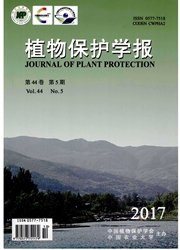

 中文摘要:
中文摘要:
玉米大斑病菌是异宗配合真菌,有性杂交有可能增强病菌的致病力,或形成新的致病小种,因此对该病菌有性杂交后代进行致病性测定和遗传多态性分析对控制该病菌的危害具有重要意义。对亲本菌株132、135和它们杂交产生的70个单子囊孢子F1代菌株进行了生理小种鉴定和AFLP(扩增性片段长度多态性)分析。生理小种鉴定结果表明,F1代菌株中与亲本菌株132(23N号小种)属于同一小种类型的占41.4%,与亲本菌株135(23号小种)相同的占20.0%,另外还出现了0、1、2、3、13、123、12N、13N和123N号小种,所占比例分别为2.9%、1.4%、2.9%、2.9%、4.3%、8.6%、1.4%、4.3%和10.0%,说明有性杂交可使后代菌株的致病性发生比较广泛的变异。AFLP分析表明,F1代菌株之间分子遗传相似系数在0.87~0.99之间,其中84.3%的F1代菌株与亲本菌株的遗传相似系数在0.878以上,但与亲本菌株132同源性较强的F1代菌株数目大约是与亲本菌株135的5倍,说明不同菌株具有不同的遗传传递能力。比较生理小种鉴定和AFLP分析结果,发现生理小种分化和AFLP分子遗传多态性间有一定的相关性,但不能完全对应,不存在遗传谱系就等于小种的简单对应关系。
 英文摘要:
英文摘要:
Sexual hybridization in Setosphaeria turcica could possibly enhance its pathogenicity and pro- duce new races, therefore, studies on its pathogenicity changes and genetic polymorphism among its descendants will accelerate the control of diseases caused by the fungus. The physiological race identification and AFLP (amplified fragment length polymorphism) analysis were conducted among the 70 single ascospores (F1 isolates) of the sexual hybridization between isolate 132 and isolate 135 of Setosphaeria turcica. The results indicated that 41.4% of F1 isolates were consistent with isolate 132 (race 23N), 20.0% of F1 isolates consistent with isolate 135 (race 23 ), the other isolates were not consistent with the parent isolates, among which 2.9% belonged to race 0, 1.4% belonged to race 1,2.9% belonged to race 2, 2.9% belonged to race 3, 4.3% belonged to race 13, 8.6% belonged to race 123, 1.4% belonged to race 12N, 4.3% belonged to race 13N, and 10.0% belonged to race 123N. The results of physiological race identification among F1 and parent isolates revealed that the sexual hybridization in fungal pathogen could produce diverse variance in pathogenicity. The results of AFLP analysis among F1 and parent isolates indicated that the genetic similarity between F1 isolates was from 0.87 to 0.99. 84.3% of F~ isolates were shown genetically similar to parent isolates with genetic similarity coefficiency of above 0. 878, but among which the number of F1 isolates similar to parent isolate 132 was about 5 times of the number similar to parent isolate 135, indicating that different isolates has different ability of genetic transmission. Comparison between the results of physiological race identification and AFLP analysis indicated that there were some correlation between physiological races and DNA polymorphism of the pathogen but not simple genetic pedigree-races relationship between them.
 同期刊论文项目
同期刊论文项目
 同项目期刊论文
同项目期刊论文
 期刊信息
期刊信息
